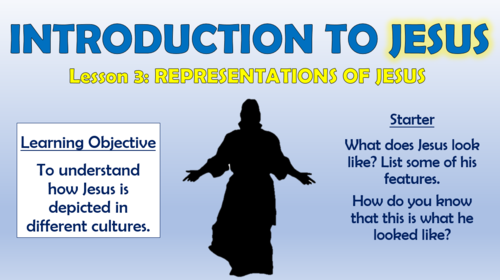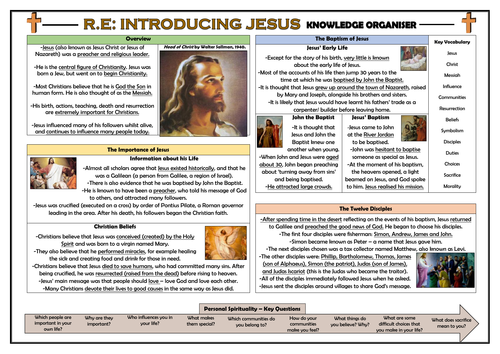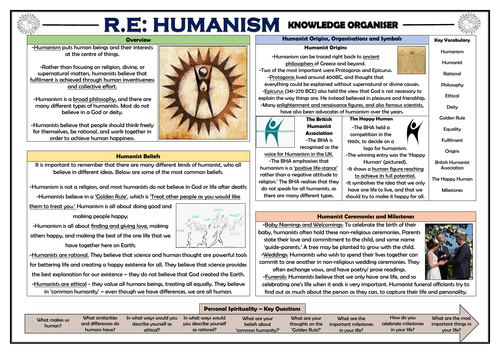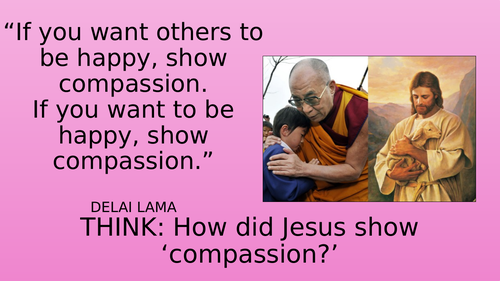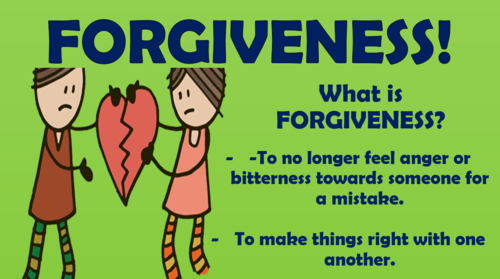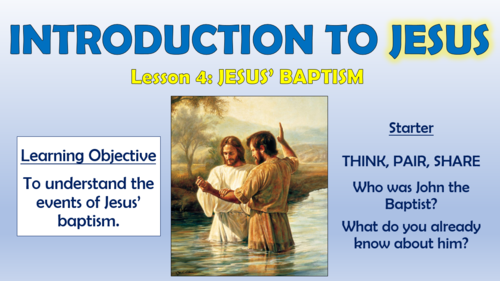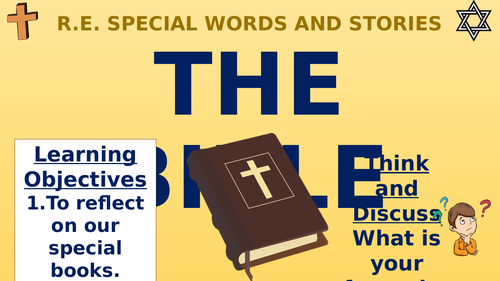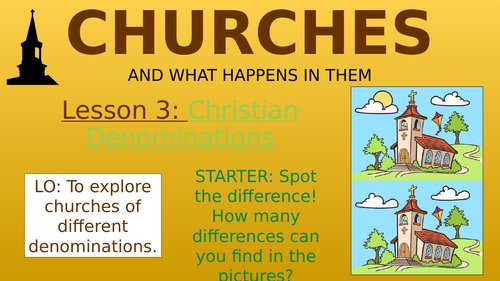
3k+Uploads
1887k+Views
2225k+Downloads
Religious education

The Bible - Interpretations of the Bible!
In this engaging and informative lesson, students learn how Christians may interpret the Bible differently. They learn about the meaning of ‘liberal’ and ‘fundamentalist’ Christians, and understand how these two viewpoints influence interpretations of different Bible stories. They learn through:
-Recalling and remembering foundation contextual facts about the Bible;
-Defining the word ‘interpretation’ and understanding that people can interpret the same things differently;
-Learning about the differences in beliefs between fundamentalist Christians and liberal Christians;
-Watching the story of Jesus’ baptism (link included) and establishing how fundamentalist and liberal Christians may interpret different sections of the story;
-Considering how their work on different interpretations may influence the way that they see and behave towards other people with different ideas to themselves.
This resource pack contains a comprehensive and colourful 15-slide Powerpoint, which guides teachers and students through the learning activities. Challenge activities are provided in order to enrich learning for higher-attaining learners. A link to the video is also included (slide 9).
In the past, I have used this lesson with children from across Key Stage 2 - the key learning is aligned with national expectations for RE, and also the content prescribed by most diocese regions.
The resource is also suitable for home learning
All images are licensed for commercial use, and are cited on the final slide.

Introducing Jesus - Representations of Jesus!
In this engaging lesson, students develop their understanding of how Jesus Christ is visually depicted in paintings, focusing on facial expression, body language, his effect on his immediate environment, and other features. They also begin to look at how Jesus has been depicted over time and in different cultures.
The learning is guided by a clear and colourful PowerPoint presentation, which guides students through the following step-by-step journey:
-Personal Spirituality - considering how people (including themselves) can be represented;
-Understanding how no one today knows for sure how Jesus looked, and the paintings that we see of him are artists’ representations;
-Analysing how Jesus is represented in some famous paintings of different events in his life;
-Creating their own painting of Jesus from an event in his life, considering how Jesus himself is represented.
This resource pack contains a comprehensive Powerpoint, alongside an eye-catching, and helpful worksheet.
In the past, I have used this lesson with children from across Key Stage 2 - the key learning is aligned with curriculum expectations for RE, and also the content prescribed by most diocese regions. All images are licensed for commercial use.

Introducing Jesus - RE Knowledge Organiser!
This clear, detailed and visually-appealing resource offers a complete reference point for children being introduced to the life of Jesus in RE. It contains comprehensive sections on:
-Overview;
-The Importance of Jesus - ‘Information about his Life’ and ‘Christian Beliefs’;
-The Baptism of Jesus - ‘Jesus Early Life’, ‘John the Baptist’ and ‘Jesus’ Baptism;’
-The Twelve Disciples;
-Personal Sprituality - Key Questions;
-Key Vocabulary.
The resource is designed to be printed onto A3, and is provided as both a PDF and a Word version (so that you can edit if you want to). All images used are licensed for commercial use and are cited on a separate document (included). It is most appropriate for KS2 children.

The Bible - Introduction to the Bible!
In this lesson, students learn about the key features of the Bible, including:
-What the Bible is comprised of;
-What the Bible tells Christians;
-Different versions of the Bible;
-Further information about the Old Testament and the New Testament;
-Different types of writing in the Bible.
Children learn through collating prior knowledge of about the Bible, watching an interesting video (hyperlinked) and recording the key information, and exploring Bibles for themselves (ensure that you have enough Bibles for each group to share one).
This resource pack contains a comprehensive 14-slide Powerpoint, alongside an eye-catching worksheet. Challenge activities are provided in order to enrich learning for higher-attaining learners.
In the past, I have used this lesson with children from across Key Stage 2 - the key learning is aligned with national expectations for RE, and also the content prescribed by most diocese regions. All images are licensed for commercial use, and are cited on the final slide.

RE - Sikhism - The Life of Guru Nanak!
In this engaging lesson, students are introduced to the Sikh religion and to the first Sikh Guru: Guru Nanak. They learn about the key events in his life, including his vision of God, and they begin to understand the importance of Guru Nanak to people who follow Sikhism.
The learning is guided by a clear and colourful PowerPoint presentation, which guides students through the following step-by-step journey:
-Considering what children already know about Sikhism, and what they would still like to know;
-Introducing children to the Sikh religion, including sharing information about where and when the faith started;
-Watching an engaging, age-appropriate video (hyperlinked) to find out about the main events of Guru Nanak’s life;
-Answering questions to check their understanding of the video information;
-Finding out key information about how the Sikh Guru tradition started as a result of Guru Nanak, and then introducing them to information about how his life is celebrated today (hyperlinked);
-Considering personal spirituality questions, including their perceptions of the Guru Nanak’s main revelations about God.
-Comparing Guru Nanak’s ‘turning point’ with the turning point of prophets/ characters in other religions;
-Completing a creative task in which they consider a ‘turning point’ in their own lives;
-Self-reflecting on the extent to which they feel they have met the learning objectives.
This resource pack includes the comprehensive PowerPoint presentation (15 slides) and the hyperlink for the video/ additional information. There is everything that you need here to teach the lesson.
In the past, I have used this lesson with children from across Key Stage 2 - (predominantly upper KS2) the key learning is aligned with curriculum expectations for RE, and also the content prescribed by most diocese regions.

KS1 RE - The Lord's Prayer!
In this engaging and important lesson, students explore the key meanings of the Lord’s Prayer. They consider why the prayer is so important for Christians, and also begin to think about the words and phrases in life that are special to them.
The learning is guided by a clear and colourful PowerPoint presentation, which guides students through the following step-by-step journey:
-Reflecting on and recalling knowledge that they already built about special words and stories in Christianity;
-Considering the words and phrases that are special to them in their lives;
-Reading the Lord’s Prayer and breaking down the key meanings, by identifying and then defining new and unfamiliar vocabulary;
-Answering comprehension questions about the key meanings of the prayer;
-Considering why the prayer is so important in Christianity;
-Creating their own prayers based on ideas that are important to them;
-Self-reflecting on the extent to which they feel they have met the learning objective.
This resource pack includes the comprehensive PowerPoint presentation (12 slides) and also a double-spaced copy of the prayer for annotation (in both Word and PDF). There is everything that you need here to teach the lesson.
In the past, I have used this lesson with children from across Key Stage 1 - the key learning is aligned with curriculum expectations for RE, and also the content prescribed by most diocese regions. All images are licensed for commercial use.

The Bible - Bible Structure and Referencing!
In this engaging and informative lesson, students learn about the structure of the Bible, and gain an understanding of how to read and apply Bible references. They learn through:
-Recalling and remembering the different sections of the Bible;
-Considering what is detailed in each section;
-Understanding how and why Bible references are used;
-Applying knowledge of Bible references to a fun ‘Find the Animal’ game;
-Challenging their friends to find different details using references;
-Completing a ‘Bible Bookcase’ to remember the different sections of the Bible.
This resource pack contains a comprehensive and colourful 15-slide Powerpoint, alongside an eye-catching worksheet (2 different versions for different levels of learners in the class). Challenge activities are provided in order to enrich learning for higher-attaining learners.
A part of the lesson includes using Bibles, so you will need enough for at least one per group in your class.
In the past, I have used this lesson with children from across Key Stage 2 - the key learning is aligned with national expectations for RE, and also the content prescribed by most diocese regions. All images are licensed for commercial use, and are cited on the final slide.

Humanism Knowledge Organiser!
This clear, detailed and visually-appealing resource offers a complete reference point for children learning about Humanism in R.E. It contains comprehensive sections on:
-Overview;
-Humanist Beliefs;
-Origins, Organisations and Symbols in Humanism;
-Humanist Milestones and Ceremonies;
-Personal Spirituality - Key Questions;
-Key Vocabulary.
The resource is designed to be printed onto A3, and is provided as both a PDF and a Word version (so that you can edit if you want to). All images used are licensed for commercial use and are cited on a separate document (included). It is most appropriate for KS2 children.
Bundle Sale

Buddhism KS2 Lesson Bundle!
Throughout this series of lessons, children are given a broad introduction to Buddhism, through a range of engaging and informative lessons. The following double-length (approx 60-90 mins) lessons are included:
-Lesson 1: The Story of Siddhartha Gautama
-Lesson 2: Suffering
-Lesson 3: The Noble Eightfold Path
-Lesson 4: Buddhist Stories
Each lesson contains a colourful, comprehensive Powerpoint to guide teachers and children through the activities and learning. All necessary worksheets, templates, and video links are also included.
I originally used these lessons with lower KS2 children, but feel that they can also be easily adapted for children who are slightly older.

RE - Special Ways of Living - Buddhist Monks and Nuns!
In this engaging lesson, students are introduced to how Buddhist monks and nuns live their lives. They consider the sacrifices that these people make and the reasons behind their choices.
The learning is guided by a clear and colourful PowerPoint presentation, which guides students through the following step-by-step journey:
-Recalling their prior learning about how Christians and Buddhists live;
-Reflecting upon an image of monks and considering what they can infer about them/ their lives;
-Learn key facts about monks and nuns, through key facts on the slideshow and engagement with a hyperlinked video that leads them through a day in the life of a Buddhist monk;
-Considering the qualities and skills that Buddhist monks and nuns need to show, and considering how they would feel/think if they were in a similar position;
-Self-reflecting on the extent to which they feel they have met the learning objectives.
This resource pack includes the comprehensive PowerPoint presentation (15 slides) and the hyperlink for the video. There is everything that you need here to teach the lesson.
In the past, I have used this lesson with children from across Key Stage 1 - the key learning is aligned with curriculum expectations for RE, and also the content prescribed by most diocese regions. All images are licensed for commercial use.

RE - Special Ways of Living - How Buddhists Live!
In this engaging lesson, students are introduced to the Buddha and the key concepts of Buddhism. They learn about how the Buddha proposed that people should live their lives and consider the different spokes on the ‘Eightfold Path’ wheel.
The learning is guided by a clear and colourful PowerPoint presentation, which guides students through the following step-by-step journey:
-Recalling their prior learning about how Christians live;
-Reflecting upon an image of the Buddha, and thinking about what the different features in the image show people about how to live;
-Learn key facts about the Buddha and how he suggested that people should live their lives, including following the ‘Eightfold Path.’
-Considering how they could apply some of the principles of the Eightfold Path to their own lives.
-Comparing and contrasting some of the key teachings of Christianity and Buddhism;
-Self-reflecting on the extent to which they feel they have met the learning objectives.
This resource pack includes the comprehensive PowerPoint presentation (16 slides) and the worksheet needed for the Eightfold Path task (in both Word and PDF). There is everything that you need here to teach the lesson.
In the past, I have used this lesson with children from across Key Stage 1 - the key learning is aligned with curriculum expectations for RE, and also the content prescribed by most diocese regions. All images are licensed for commercial use.

Judaism - Moses and the Burning Bush - Lesson!
In this engaging lesson, students are introduced to the story of Moses and the Burning Bush. They are encouraged to think deeply about the meanings that can be taken from the story, and consider the main ‘turning points’ in their own lives and the lives of others.
The learning is guided by a clear and colourful PowerPoint presentation, which guides students through the following step-by-step journey:
-Knowledge recall - gauging children’s prior knowledge of Judaism - including Jewish persecution in Egypt and Moses’ early life;
-Reading the story of Moses and the Burning Bush - pausing for reflective thought by engaging with the embedded questions;
-Considering the deeper meanings and morals of the story - including Moses’ killing of the Egyptian and his worries about leading the Israelites;
-Considering their own attitudes towards the events and characters in the story;
-Comparing Moses’ turning point with turning points from other religions;
-Thinking of how turning points in their own lives have affected them;
-Completing a plenary to assess their understanding.
This resource pack contains a comprehensive 15-slide Powerpoint and the story/ consideration questions (in both Word and PDF).
In the past, I have used this lesson with children from across Key Stage 2 - the key learning is aligned with curriculum expectations for RE, and also the content prescribed by most diocese regions. All images are licensed for commercial use.

Shahada - The First Pillar of Islam!
In this engaging and comprehensive lesson, students are introduced to the first pillar of Islam - the Shahada.
Children learn through collating their collective prior knowledge, watching an interesting video (hyperlinked) and answering comprehension questions about the Shahada. They then link this knowledge to their own personal spirituality, considering the important ‘pillars’ and intentions that are important to them and their communities.
The lesson is tried and tested, and is easy for teachers and students to follow. It contains a comprehensive 16-slide Powerpoint which offers a step-by-step guide throughout the lesson, in addition to the worksheet template for the creative ‘pillars of my community’ activity (in both Word and PDF). Challenge activities are provided in order to enrich learning for higher-attaining learners.
In the past, I have used this lesson with children in upper Key Stage 2 (years 5 and 6). The key learning is aligned with national expectations for RE, and also the content prescribed by most diocese regions. All images are licensed for commercial use, and are cited on the final slide.

The Nativity Story - Whole Class Reading Session!
This informative and engaging whole class reading session deepens children’s understanding of the Nativity Story, whilst also developing vital reading comprehension skills such as retrieving, interpreting, inferring and sequencing. I have used these resources as an adaptation to our usual whole class reading provision throughout the lead-up to Christmas.
The resource pack includes the link to the version of the story needed, which is most suitable for children in lower KS2 (although some higher attaining KS1 children may also be able to access it successfully).
This is followed by a series of activities aiming to develop children’s retrieval, explanation, inference, prediction and summarising skills. It also contains a vocabulary check immediately after the extract is read to clarify any unfamiliar/ difficult language.
The tasks are comprised of quick-check questions, solo thinking, pair/ group discussions and deeper thinking activities.
The resources have been received well by teachers and children, with a number of collegues choosing to split the content over two sessions.
All images are licensed for commercial use.

Compassion - Collective Worship Session!
This fun and original collective worship session aims to assist children in understanding the value of being compassionate, through:
Understanding what compassion is, and recognising why it is important;
Understanding what the bible teaches us about compassion, and learning about how Jesus was compassionate;
Looking at examples of behaviour that is compassionate and not compassionate (including through role play activities and videos), and noting its effect on people in need;
Learning strategies to demonstrate compassion in their own lives.
This worship session is tried and tested, and has always been really well received in the past. The slides are visually engaging and well-presented, and the subject matter is tailored to the interests and needs of young people. For example, there are references to scenarios and dilemmas that they themselves might find themselves in (for example how they might act towards those in need both within and out of school) in order to help them to make the right choices in their own lives.
The session also includes a fun role-play task, a beautiful, thought-provoking video about the importance of compassion, and various discussion activities regarding how to show compassion in different areas of their own lives. No further resources are required, everything that you need to present the assembly is included. This includes a child-friendly adapted bible story about Jesus demonstrating compassion towards a man with leprosy.
The slides are fairly self-explanatory, but I’ve included two pages of notes to assist the speaker. Hope that you find this useful!

Forgiveness Collective Worship Session!
This fun and original collective worship session aims to assist children in understanding the value of showing forgiveness, through:
Understanding what forgiveness is, and recognising why it is important;
Understanding what the bible teaches us about forgiveness, and learning about how Jesus demonstrated forgiveness;
Looking at examples of times when they may need to forgive others or seek forgiveness, through stories and scenarios;
Learning strategies to demonstrate forgiveness in their own lives.
This worship session is tried and tested, and has always been really well received in the past. The slides are visually engaging and well-presented, and the subject matter is tailored to the interests and needs of young people. For example, there are references to scenarios and dilemmas that they themselves might find themselves in (for example how they might act during and after conflicts) in order to help them to make the right choices in their own lives.
The session also includes an enduring real-life story of Nelson Mandela’s forgiveness of others, an engaging video depicting the bible story of how Jesus forgave Peter, and various discussion activities regarding how to show forgiveness in different areas of their own lives. No further resources are required, everything that you need to present the assembly is included.
The slides are fairly self-explanatory, but I’ve included two pages of notes to assist the speaker. Hope that you find this useful!

Introducing Jesus - Jesus' Baptism!
In this engaging lesson, students are introduced to the events and significance of the baptism of Jesus Christ.
The learning is guided by a clear and colourful PowerPoint presentation, which guides students through the following step-by-step journey:
-Knowledge harvesting - gauging what children already know about John the Baptist;
-Learning about the life of John the Baptist;
-Watching a short video (hyperlinked) about the Baptism of Jesus Christ;
-Freeze Framing Activity - The main events of the Baptism;
-Considering deeper thinking questions on the significance of the Baptism;
-Personal Spirituality - Milestones and turning points in our own lives.
This resource pack contains a comprehensive Powerpoint, alongside a clear and detailed information sheet for the introductory activity.
In the past, I have used this lesson with children from across Key Stage 2 - the key learning is aligned with curriculum expectations for RE, and also the content prescribed by most diocese regions. All images are licensed for commercial use.

KS1 RE - Special Words and Stories - The Bible!
In this engaging lesson, students develop their understanding of the Bible, and why it is special to Christians. They also consider the words and stories that are meaningful to themselves. It was originally taught as a part of an RE unit on ‘Special Words and Stories.’
The learning is guided by a clear and colourful PowerPoint presentation, which guides students through the following step-by-step journey:
-Thinking about which stories are meaningful to them, and why they hold special meaning;
-Introducing children to the Bible, and developing their understanding about who it was written by, how it is structured, and the different types of writing that we can be found within it;
-Understanding why the Bible is special to Christians, including reflecting on a child-friendly version of The Good Samaritan, to demonstrate how Bible stories teach Christians important messages;
-Completing a plenary activity to assess their understanding;
-Self-reflecting on the extent to which they feel they have met the learning objective.
This resource pack includes the comprehensive PowerPoint presentation (15 slides) and the hyperlinks to the video resource in the development activity. There is everything that you need here to teach the lesson.
In the past, I have used this lesson with children from across Key Stage 1 - the key learning is aligned with curriculum expectations for RE, and also the content prescribed by most diocese regions. All images are licensed for commercial use.

RE - Islam - Features of Mosques!
In this engaging and comprehensive lesson, students are introduced to the main features of mosques. They learn the names and purposes of a number of different features of mosques, including minarets, domes, prayer halls, and mihrabs.
Children learn through collating their collective prior knowledge, accessing an engaging interactive online resource (hyperlinked) where they can explore a mosque, and recording the key information. They conclude by comparing the features of mosques with what they know about churches.
The lesson is tried and tested, and is easy for teachers and students to follow. It contains a comprehensive 15-slide Powerpoint which offers a step-by-step guide throughout the lesson. Challenge activities are provided in order to enrich learning for higher-attaining learners.
In the past, I have used this lesson with children from across Key Stage 2 - the key learning is aligned with national expectations for RE, and also the content prescribed by most diocese regions. All images are licensed for commercial use, and are cited on the final slide.

Churches - Christian Denominations!
In this lesson, students learn about the a number of the main types of Christianity, including Protestant (Anglican), Roman Catholic and Orthodox denominations.
Children learn about why there are different kinds of Christianity, before exploring the features of each faith and the respective churches.
This resource pack contains a comprehensive 14-slide Powerpoint, alongside all of the resources needed. A creative extension activity is also provided in order to challenge higher ability learners.
In the past, I have used this lesson with children from across Key Stage 2 - the key learning is aligned with NC expectations for RE, and also the content prescribed by most diocese regions. All images are licensed for commercial use, and are cited on the final slide.
Note - children will need access to computers/ books in order to complete the research task.


